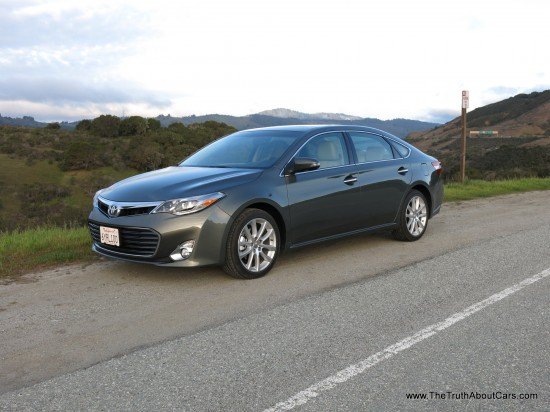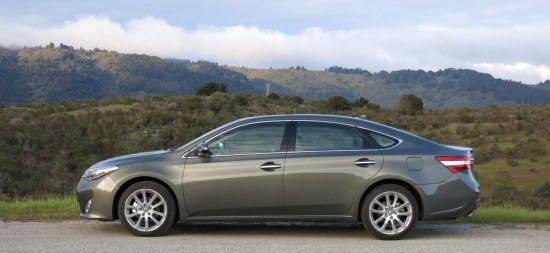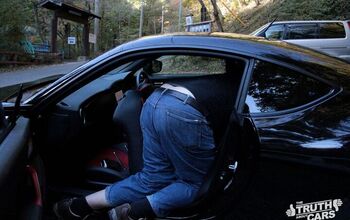Review: 2013 Toyota Avalon Limited (Video)

The Avalon has been something of a caricature since it wafted on stage in 1994. The stretched Camry was low on soul, devoid of style and soft of spring. In short, it was the Buick that wouldn’t leave you stranded. Since then Toyota has struggled to divine a mission for their full size sedan, a problem complicated by the re-invigoration of the large sedan market by the American brands. In hopes of resurrecting sales numbers, which have slid to 25% of their 2000 year shipments, Toyota has injected something hitherto unseen in an Avalon: style. Is it enough?
Before we dive into the Avalon, let’s talk competition. Back when the LHS and Park Avenue roamed the land, the Avalon’s competition was easy to identify and easy to overcome. Nearly 20 years later those shoppers are in a nursing home and Toyota is hunting for younger flesh in a more competitive market. We now have the larger-than-ever Taurus, a new Impala that doesn’t make me want to put my eyes out, the Azera/Cadenza twins, Nissan’s Maxima and the less-Bentley aping 300.
But wait, I’m forgetting one. The “elephant in the room” that is the Lexus ES. You see, the kind of shopper that needs a new car and immediately thinks “Toyota Avalon” is far more likely to cross shop the Lexus ES than the gangsta 300 or the Impala. (You know I’m right.) After spending a a week with the twins back-to-back, this comparison is even more valid.
Exterior
While the “I’m a bigger Camry” look is still going on, Toyota has injected enough creases and curves that my 33 year old eyes gave the Avalon a second look (of course, I did buy a 2000 LHS new in 2000, so…) It’s not as exciting as the new Cadenza, but Toyota’s efforts look better thought out than the 11/10ths Cruze grille Chevy put on the Impala.
The new rump features more chrome, dual exhaust tips and tail lamps that wrap well around the side and thankfully share no styling cues with the Camry’s funky “apostrophe” shaped lights. The engineers stretched the greenhouse over the trunk to increase the visual length of the car, a trick that worked on me until I looked at the spec sheet. At 195 inches, the Avalon is 6-inches longer than the Camry, but it’s several inches shorter than the Chrysler, Chevy and Ford. Since the ES and Avalon are now twins separated at birth, most of the dimensions are common except that the Avalon gets a bigger booty (and more trunk space in the process) and has a lower ride height giving it a more aggressive stance.
Interior
The exterior looks like a Toyota product. No news there. Inside is a different ball of wax. The interior is why you may have heard people saying they prefer the Avalon to its Lexus sister. If you recall from our review of the Lexus ES 300h, there were plenty of hard plastics within reach of the driver, and instead of a leather dash (like the 300 wears) or stitched pleather goodness like the competition is wearing, the ES stuck with an injection molded dashboard “faux-stitched” with real thread. In an unexpected contrast, the Avalon’s interior has a more premium feel, thanks largely to heavy use of (you guessed it) stitched pleather. The faux-cow in the Avalon may not be hand-sewn (Toyota is mum on the subject) but its liberal use on the doors, dashboard and center console beat every competitor (except for that Chrysler with the leather dashboard option.)
My lunch group was divided about the styling, some feeling that Toyota had gone too far and the rest thinking it was a bold choice for Toyota. I fell into the latter camp. Yes, there’s an enormous driver’s window defogger vent (in the picture above), but I appreciate the fact that a styling direction was chosen rather than just repeating the same “beige” the Avalon has been known for. That a group of adults in their 30s were arguing the merits of an Avalon interior is nothing short of revolutionary.
Compared to the Avalon’s Lexus sister, the interior has a more expansive and harmonious feel despite the heavily styled parts. I think I chalk some of this up to the tan-on-black color scheme our tester sported, but plenty of it has to do with dashboard shapes. Lexus’ two-tier dashboard and the “high and centered” position of the infotainment screen make the dashboard feel more imposing than the Avalon’s sweeping forms and less “bulky” dashboard on the passenger’s side.
The front seats are functionally identical to those in the ES with the exception that the number of power-motions varies by the trim level. The thrones are thickly padded and comfortable for long journeys but larger shoppers should know that they are more “bucket” shaped than previous models. Taller drivers and passengers will appreciate the largest cabin Toyota has ever built, including the LS 600hL. With 42.1 inches of legroom up front, 39.2 in the rear, and class leading headroom, the Avalon swallows those tall kids of yours more easily than any front driver this side of the Cadillac XTS. How does Toyota do this with a shorter sedan? They “skimp” on trunk space. Our tester’s 16 cubic foot trunk is nearly 25% smaller than the Taurus and 18% smaller than the Impala.
Infotainment & Gadgets
The Avalon comes in four trim levels, three of which have no available options for the picking. Things start with the $30,990 XLE which comes well equipped with 8 speakers, a touchscreen audio system, Bluetooth integration, dual-zone climate control, keyless go, and a heated 8-way power seat for the driver. The $33,195 XLE Premium tosses in a moonroof, backup cam, an extra speaker, and an auto-dimming rear-view mirror. For $35,500 the XLE Touring adds navigation, shift paddles, driver’s seat memory, fog lights, 18-inch wheels with 225-width rubber, and Toyota’s Entune data services. Our tester was the top-of-the-line Limited which starts at $39,650 and gets auto-dimming side mirrors with puddle lamps, HID headlamps, 11 JBL speakers, rain sense wipers, three-zone climate control, heated rear seats, ambient lighting, a color HVAC control panel, and a passenger seat with eight powered directions instead of four. Limited buyers can further option their car with two technology packages, for $1,750 you get radar cruise control with pre-collision warning and automatic high beams and for an extra $200 Toyota will integrate a wireless charging mat into the console.
On the infotainment side it is important to remember that Toyota makes two different systems that share nothing with one another. The picture above is the 7-inch system in our Limited tester and the picture below is the 6.1 inch “display audio” system in lesser Avalons. The 6.1 system has more basic graphics but is more responsive and is designed around an “app” model where things like navigation (available only on the Touring trim) are just another “app” available via the “apps” button on the dash. The 7-inch system uses XM Satellite data services while the 6.1 uses your paired smartphone for dynamic content. The 6.1 provides a fairly basic navigation experience, but it is easy to use and very responsive. The 7-inch system (only on Limited) is the familiar Toyota/Lexus system that’s been around for several years that has been updated with Entune data services, smartphone app integration and voice commands for controlling your media device ala Ford’s SYNC. This is the same software used in the Lexus, except without the atrocious “Remote Touch” joystick.
Going back to the ES comparison, since the Limited model uses essentially the same system, driving the ES and Avalon back to back served to solidify my dislike of the Lexus pain stick. The exact same interface is considerably easier to use, less distracting and more intuitive when you can glance at the screen and stab the option with your finger.
Drivetrain
The 3.5L V6 is buttery-smooth, but churns out a less-than-thrilling 268 HP and 248 lb-ft of twist. For reasons I don’t understand, Toyota has yet to fit their D4-S direct-injection system which would make it more competitive on paper (the competition are all around 290 HP). (Ford of course still offers the insane 365HP twin-turbo V6.) Proving that horsepower isn’t everything, the Avalon’s light 3,461lbs curb weight allows it to scoot to 60 in 6.25 seconds, among the fastest in the group behind the 365 HP Taurus SHO and the 290 HP Maxima (thank the Nissan CVT). While we haven’t been able to get our hands on the new Impala, expect it to be fairly quick thanks to its low curb weight as well. Meanwhile the 300 V6, LaCrosse, Azera, MKS and plenty of others will be seen in the Avalon’s rear view mirror.
The only major change for 2013 is the fitting of paddle shifters to the 6-speed automatic transaxle in Touring and Limited trims. With the paddles comes revised software that blips the throttle on downshifts. Don’t get too excited, since this cog swapper is just as up-shift-happy and down-shift-resistant as it was before.
For $2,360 on XLE Premium and $1,750 on Touring and Limited you can opt for Toyota’s 200 HP hybrid system. This is the same setup under the hood of the Camry and ES 300h and increases the Avalon’s MPGs from 21/31/25 (City/Highway/Combined) to 40/39/40 resulting an a savings of $900 per year at $4 a gallon. The trade off is the loss of one full second on the run to 60, well worth the cost in my book.
Drive
For 2013 the Avalon has ditched the wallowy ride synonymous with the model in favor of stiffer springs and a more buttoned down demeanor. Thanks to the new found corner carving skills and a curb weight that is 600lbs lighter than the Taurus, the Avalon is more engaging, composed and nimble than the heavy Ford. Notice I didn’t say “handles better.” The reason the Taurus clings onto first place in our road holding test is down to rubber, seriously wide 255/45R19 rubber (Taurus Limited.)
The Hyundai Azera and its Kia cousin are well-priced alternatives. While the Avalon beats them handily in terms of interior refinement, the Koreans have plenty of power (293 HP) and coupled with a curb weight that’s only 150-200 lbs more than the Avalon they are quicker off the line. Thanks to more aggressive rubber and excellent suspension dynamics the pair is also faster around a track. Of course, shoppers in this segment don’t really care about handling limits and that’s a problem for the dynamic duo because their refinement quotient is still a notch below the new Avalon.
Nissan’s Maxima is fairly light at 3,565lbs and has one of the more powerful engines at 290 HP and 261 lb-ft of twist. Thanks to the low starting ratio and step-less nature of the Nissan CVT, the Maxima burns rubber on its way to the best 0-60 time in this bunch of 5.6 seconds. Of course I can’t talk Nissan without admitting that the CVT isn’t the “sporting” choice because of the “rubber-band” like feel they impart but I don’t think its much of a problem in this segment. On the down side, the Maxima is starting to show its age in a stable of products shifting to a new design language.
The Chrysler 300 is the odd man out. I’m including it because some of our readers would have complained if it had been left out. The problem is the 300 appeals to an entirely different sort of person, both because of its aggressive looks and its RWD drivetrain. Still, the 300 V6 would be my personal choice in this shootout, but I have to acknowledge that a bold RWD American sedan isn’t everyone’s cup of tea. Chrysler’s smooth 292 HP V6 and the slick ZF 8-speed automatic are no match for the 300’s higher curb weight making the 300 slower to 60 by nearly a full second. Although I prefer the RWD dynamics of the 300, the heavier curb weight means the Avalon is the nimbler choice. On the flip side, the 300 Luxury Series (the most appropriate cross shop) has a gorgeous full-leather dash and the ride of a full-sized luxury sedan.
That brings us full circle to the elephant in the room: the 2013 Lexus ES. Our Avalon Limited tester has so far knocked the ES to its knees by delivering a better interior, nearly identical feature content, and an easier to use infotainment system. Of course, siblings fight dirty and the Avalon kicks her sister while she’s down by handling better thanks to stiffer springs and wider rubber. When you factor in the Avalon’s lower sticker price and the reality that the Avalon and ES are likely to be as reliable as one another and cost essentially the same to maintain, you have to ask yourself how much that Lexus logo is worth to you. Even outside the direct Toyota vs Lexus comparison the Avalon is highly competitive with an excellent interior, plenty of power, huge back seat and a price tag that isn’t as frightening as the “luxury” alternatives. I never thought I would say this about the Avalon: it’s the aggressive sister that knocks down her stuck-up twin and steals the boyfriend by promising to be a cheaper date. Since I like my women cheap and feisty, I’d take the Avalon up on her offer and only think about the ES once a year at family reunions.
Hit it
- The best interior with a Toyota badge.
- Never thought I would call an Avalon “nimble.”
- “Better” than the Lexus for less.
Quit it
- No ability to add navigation to the base display audio system.
- 268 HP is nothing to brag about in 2013.
- Smaller trunk than the competition.
Toyota provided the vehicle, insurance and one tank of gas for this review
Specifications as tested
0-30: 2.55 Seconds
0-60: 6.25 Seconds
1/4 Mile: 14.51 Seconds @ 98.8 MPH
Average Fuel Economy: 23.2 MPG over 534 Miles

More by Alex L. Dykes
Latest Car Reviews
Read moreLatest Product Reviews
Read moreRecent Comments
- SCE to AUX They're spending billions on this venture, so I hope so.Investing during a lull in the EV market seems like a smart move - "buy low, sell high" and all that.Key for Honda will be achieving high efficiency in its EVs, something not everybody can do.
- ChristianWimmer It might be overpriced for most, but probably not for the affluent city-dwellers who these are targeted at - we have tons of them in Munich where I live so I “get it”. I just think these look so terribly cheap and weird from a design POV.
- NotMyCircusNotMyMonkeys so many people here fellating musks fat sack, or hodling the baggies for TSLA. which are you?
- Kwik_Shift_Pro4X Canadians are able to win?
- Doc423 More over-priced, unreliable garbage from Mini Cooper/BMW.



































































![2016 Toyota Tacoma Limited Review - Off-road Taco Truck [Video]](https://cdn-fastly.thetruthaboutcars.com/media/2022/07/19/9235237/2016-toyota-tacoma-limited-review-off-road-taco-truck-video.jpg?size=350x220)











Comments
Join the conversation
I purchased my first Avalon in 2004 and it was a 2000 model XLS. It had 120K on it when I got it, and I paid $8400. I drove it for 3 years spent about $500 on repairs and sold it for $5800 with 245K on the clock. Original starter, alternator, struts, and of course trans and motor. It was comfortable, quiet, and got about 28mpg on highway. Due to the high miles I drive, I prefer to purchase cars to use for the 2nd half of their life. I like to read reviews for cars that I may purchase in 4 or 5 years as used. I have never had much luck with any of the big three going much past 180K. It is not catastrophic failures like trans or motor but all the "little" things that eat up time and money.
In measurements, the Lexus ES actually has two more inches of rear legroom. The ES does have a bigger back seat. And getting the luxury Lexus badge, with Lexus service, is definitely worth the premium for many people. Plus the styling of the two cars, inside and out, is very different. In practice, both cars are selling fast, and are virtually identical in sales, YTD BD